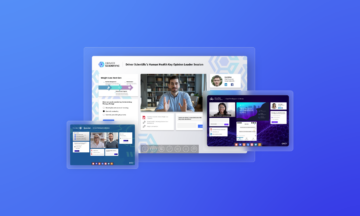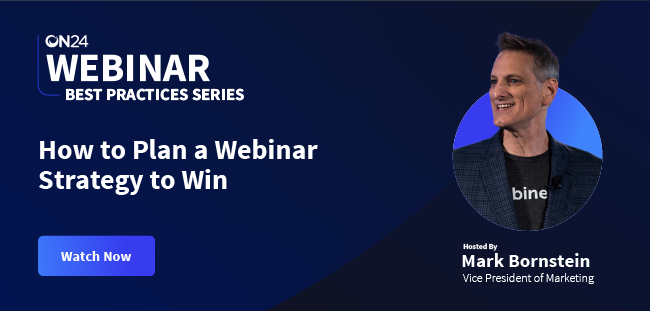Generating predictable pipeline requires more than a series of individual tactics to generate leads. It requires a digital engagement strategy capable of building real relationships and giving our sales team more to work with than just names on a list.
This is where the modern webinar comes into play. As our marketing continues to evolve, so must our webinar strategies. A well-orchestrated webinar is so much more than a lead generator. It can deliver the insights you need to accelerate the buying journey and, ultimately, convert prospects into pipeline.
Read on to learn how to plan, target and optimize your webinar programs to attract, engage and convert as part of either a B2C or B2B webinar strategy.
Define your audience

Knowing who your audience is will help you customize every experience and optimize them for better results.
When defining your audience, keep in mind the following:
-
- Persona: One message does not fit every audience. A practitioner might be looking for more tactical content they can apply right away as opposed to an executive who might prefer a high-level discussion with an exclusive group of peers.
- Unique audience segments: Every target prospect list has different types of businesses, verticals and unique use cases. Experiences unique to one may not be relevant for another. Keep your audience in mind when building, promoting and following up on your webinars to ensure you are serving up only what is most relevant to them.
- Stages of the buying journey: A top-of-funnel audience may be more interested in a thought-leadership webinar whereas someone on the verge of a purchase decision may benefit from a more product-focused experience.
Optimize your webinars

Treating the optimization of webinars as a marketing strategy is as important as what the actual webinars contain.
Webinar program planning
First things first, you must map out your webinar programs as far in advance as possible. This will help you ensure your webinars align with your broader campaign messaging and fit nicely into your overall program calendar.
This is also a great time to determine the experience types and formats you want to create with your webinar strategy. For example, to grow audiences, many companies deliver serialized webinars that buyers can subscribe or opt in to. These can be delivered in unique format types like newscasts, talk shows, roundtable discussions, fireside chats — you name it. Don’t be afraid to get creative!
That said, remember to stay agile. As trends change, so will your webinar topics — but planning ahead will make it easier to roll with the punches as you execute (and pivot) throughout the year.
Pro tip: Creating templates for each webinar series, including consoles and promotional assets, will make it easy to rinse and repeat these experiences as you go.
Individual webinar planning
When building out each webinar, remember that these experiences are about more than just delivering content. They are about engaging each unique audience in ways that are meaningful to them and deliver actionable insights for you.
The good news is, there are so many ways to get to know your audiences by optimizing every webinar with plenty of ways for them to interact and engage, including:
-
- Opportunities to ask questions
- Surveys and polls
- Links to relevant content
- Invitations to upcoming events
- Links to free trials and product demos
- CTAs to “book a meeting” or “chat with a sales rep”
The more engagement tools you include, the more opportunities your audience has to tell you where they are in the buying journey.
Pre-and-post webinar strategy

What happens before and after the webinar is just as important as the webinar itself. Even a confirmation email can be a valuable interaction between you and your buyer. Why waste it? Engage with attendees before the webinar even begins by including links to thought–leadership pieces, invitations to upcoming events or links to on-demand experiences.
The same goes for follow-up. If you’ve optimized your webinars properly, you’ve likely captured tons of great insights on your attendees that will help you personalize your follow-up messaging and deliver additional related content.
For example, if you see that someone requested a demo during the webinar, it’s safe to assume they might be ready to set up a meeting with a sales rep. If they downloaded a piece of thought-leadership content, they might enjoy a customized follow-up page with a few additional resources.
The point is, take advantage of every single touchpoint. According to Forrester, it now takes 27 interactions to reach a purchase decision, so look for ways to deliver as many interactions as you can before, during and after your webinars, and make them count.
Sales Enablement

Integrating sales teams into your webinar programs is the best way to accelerate sales cycles and keep hot leads from turning cold. SQLs have a short shelf life, so keeping track of their intent signals and relaying that information to sales teams (and fast) is mission-critical.
Now that you’ve optimized webinars for maximum engagement, you have all these incredible insights. It’s time to put that data to work by putting it into the hands of your sales teams.
The best way to do this is by integrating all this fantastic engagement data so that the audience insights you collect will automatically feed into your CRM and activate your sales teams.
Your sales teams can’t afford to waste touches on cold calls. Give them the insights they need to make warmer introductions and close more deals.
Webinars are more than just a tactic to generate leads. A strategic approach to webinar marketing puts audience engagement at the center of the experience, enabling you to generate the kind of insights you need to build real relationships.

